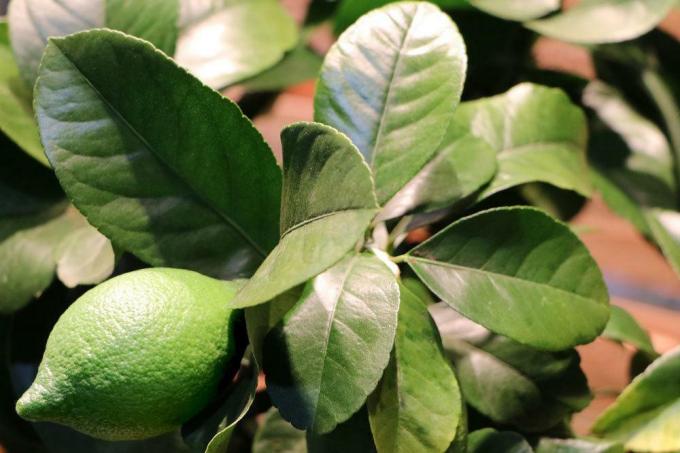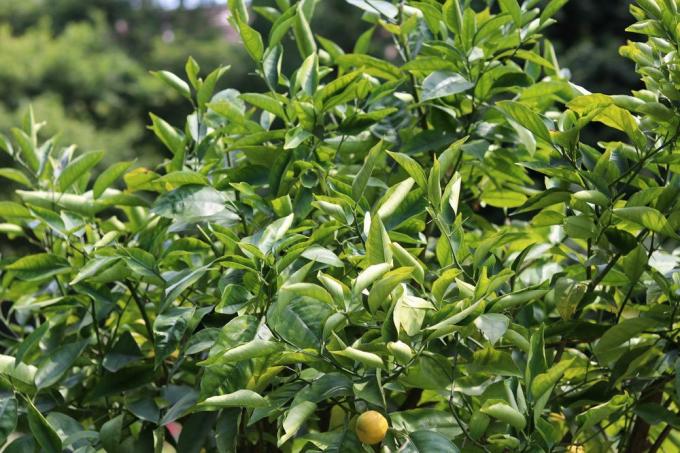
table of contents
- Discolored foliage
- Water supply
- Nutritional deficiency
- Pests
- Location
- Preventive measures
Plants have their own way of drawing attention to deficiencies in care or diseases. Crippled leaves, discoloration and small fruits are typical signs that the lemon tree is not doing well. Yellow leaves on citrus plants are a serious problem. The constant loss of foliage weakens the plants and can lead to the death of the Mediterranean plants.
Discolored foliage
Yellow discolored foliage on lemon Tree
There can be various causes if the leathery leaves of the citrus tree discolor and fall out more often during the main vegetation period. A weak formation of flowers and small fruits should also not be taken lightly by passionate lovers of the Mediterranean plants.
Only those who recognize the cause in good time and remedy the reason can protect the perennial plant from further damage. If the discoloration is due to a care error, lemon trees need time to react to the correct measures. It can take up to 3 weeks before the plants show how effective the measures taken were.
The following points can cause the leaves to discolour:
- too dark a location
- Nutritional deficiency
- Waterlogging
- Pests

Citrus plants are evergreen plants that only take a break in the cold season. The abnormalities in the warmth-loving plants can also occur in winter quarters.
Water supply
The optimal supply of water
Increasing, flat discoloration of the foliage can be due to waterlogging. When it comes to watering, the lemon tree is very demanding. The evergreen plants are used to short-term drought. Wet feet affect the Mediterranean exotics and lead to a loss of foliage. Standing water on the bottom of the bucket can promote the infestation with hose fungi. These pathogens cause the root rot that is feared by gardeners. The use of fungicides is ineffective in this case.
Keep the following tips in mind when supplying water:
- Water as needed
- Earth must be able to dry off
- Use water with a moderate amount of lime
One of the most important preventive measures is a functioning drainage. In potted plants, this layer consists of porous material that is laid out on the bottom of the container. Excess water in planters and saucers should be emptied regularly. If you are brave enough to plant the lemon trees in the bed, the substrate should be covered with small pebbles or pebbles. Mix the expanded clay. In this way, the soil is permanently loosened and does not stick together even in extreme drought.

If there is a flat yellow discoloration, it is advisable to act quickly. The lemon tree can be saved as long as no root rot has occurred at an advanced stage.
- immediately stop the supply of water
- Move plants to fresh, dry substrate
The plants should only be watered with a greatly reduced amount of water for 2 to 3 weeks. When the foliage takes on its original color, the danger is over. Incidentally, prolonged drought can also cause discoloration. Another symptom: the young leaves curl up and wither. You can check with the top tip of your index finger whether the plant needs water. If the top substrate layer feels completely dry, the time has come for it.
Nutritional deficiency
The lemon tree is one of the weakly consuming plants. However, the Mediterranean plant can only cope with completely poor soil to a limited extent. Especially older plants in the tub, the substrate of which has not been changed for a long time, suffer from a lack of nutrients. Chlorosis is a form of iron deficiency that shows itself impressively by a yellowish discoloration of the leaf veins. Small flowers and stunted shoots are further signs of a lack of nutrients.
- use ferrous fertilizer
- start in the main growing season
- Repot or repot potted plants annually. Change substrate
Fertilize according to the instructions on the package. An excessive intake of iron-containing nutrients can have the opposite effect in the lemon tree. The plant does not recover, the roots of the exotic are unable to process the high concentration of fertilizer. The plant does not need any nutrients in the winter months. There is often another cause here, if the plant changes color and loses its foliage.
In addition to chlorosis, there are other characteristic signs of nutritional deficiency. A cloudy color on the leaves is an indication of zinc or zinc. Magnesium deficiency. It is advisable to fertilize the lemon tree in a variety of ways. The most important treatment measure for an undersupply of nutrients.

- put the crop in humus-rich soil
- start adding fertilizer immediately
Pests
Detect pests in good time
A sole infestation with harmful insects causes in rare cases "only" a yellow coloration of the lemon tree. Mostly they are gray or black spots on the leaves that a visit from lice and mites brings with them. If the plant surface sticks, you should still take a closer look at the citrus plant. A large part of the cell sap sucking pests prefer to colonize the underside of the foliage and the shoot axes.
- Pour with nettle stock
- Wipe off affected parts of the plant
- Increase humidity
Setting up special pheromone traps has proven useful for indoor plants. The sticky surface of these prepared products can lead to a strong decimation of the pests. In contrast to the other causes, which are responsible for the discoloration of the lemon tree leaves, there is a risk of damaging insects for neighboring plants. If it can be set up in terms of space, the affected plants should be placed in quarantine. Fallen or removed leaves belong in the trash, not on the compost in the garden.
Location
The wrong location
The lemon tree is a sun-hungry plant. The Mediterranean shrub feels at home in the bright winter garden. The plant also thrives splendidly on the sunny balcony and in the light-flooded rock garden. A lack of light can cause noticeable features on the leaves.
- Avoid partially shaded locations
- dark places are unsuitable for the citrus plant
- avoid the proximity to shade-giving plant neighbors
As with a pest infestation, when there is a lack of light, the external features rarely only appear in the form of yellow spots and leaf loss. Give the plant a sunny spot and check whether other factors could be responsible for the abnormalities.
Preventive measures
A well-known saying goes: prevention is more effective than treating the cause. This statement applies exactly to the citrus tree. The cultivation of the Mediterranean plant is not complicated, but there are a few important requirements to be met when it comes to caring for it.

- choose the right location
- only water in small amounts
- the plant tolerates small amounts of lime
- Provide with fertilizer from March to August
- increase the humidity
- examine the citrus tree for pests
These points are easy to implement and sustainably promote the health of the citrus tree.



